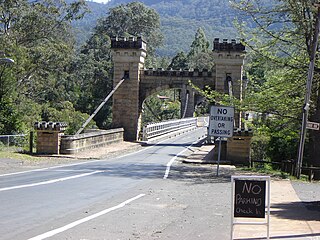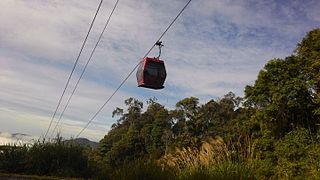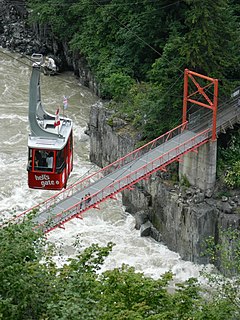
The phrase suspension bridge is a polyseme, used to describe

An aerial tramway, sky tram,cable car, ropeway or aerial tram is a type of aerial lift which uses one or two stationary ropes for support while a third moving rope provides propulsion. With this form of lift, the grip of an aerial tramway cabin is fixed onto the propulsion rope and cannot be decoupled from it during operations.

An aerial lift (U.S.), also known as a cable car, is a means of cable transport in which cabins, cars, gondolas, or open chairs are hauled above the ground by means of one or more cables. Aerial lift systems are frequently employed in a mountainous territory where roads are relatively difficult to build and use, and have seen extensive use in mining. Aerial lift systems are relatively easy to move and have been used to cross rivers and ravines. In more recent times, the cost-effectiveness and flexibility of aerial lifts have seen an increase of gondola lift being integrated into urban public transport systems.
The Mettlen–Lavorgo powerline, also called the Lukmanier powerline, is the 400 kV three-phase alternating current high voltage electric power transmission line over the Lukmanier Pass in Switzerland, from Mettlen substation, next Inwil, about 7-kilometre (4.3 mi) south of Hochdorf, to Lavorgo substation, next Lavorgo, about 5-kilometre (3.1 mi) south of Faido. Trees falling on the line in 2003 caused a major blackout in Italy.

The Singapore Cable Car is a gondola lift providing an aerial link from Mount Faber on the main island of Singapore to the resort island of Sentosa across the Keppel Harbour. Opened on 15 February 1974, it was the second aerial ropeway system in the world to span a harbour, after Port Vell Aerial Tramway in Barcelona, which opened already in 1931. However, it is not the first aerial ropeway system to span the sea. For instance, Awashima Kaijō Ropeway in Japan, built in 1964, goes over a short strait to an island. Although referred to by its operators as a cable car, the listed system is in fact a monocable gondola lift and not an aerial tramway. In 2020, a round-trip ticket cost SGD 35 for adults and SGD 25 for children.

Hampden Bridge is a heritage-listed single-span suspension bridge that carries Moss Vale Road (B73) across the Kangaroo River, in Kangaroo Valley, in the City of Shoalhaven local government area of New South Wales, Australia. The bridge was designed by Ernest de Burgh and built by Loveridge and Hudson. The property is owned by Roads and Maritime Services, an agency of the Government of New South Wales. It was added to the New South Wales State Heritage Register on 2 August 2019.

Wire rope is several strands of metal wire twisted into a helix forming a composite rope, in a pattern known as laid rope. Larger diameter wire rope consists of multiple strands of such laid rope in a pattern known as cable laid.

The Seilbahn Zugspitze is an aerial tramway running from the Eibsee Lake to the top of Zugspitze. It currently holds the world record for the longest freespan in a cable car at 3,213 metres (10,541 ft) as well as the tallest lattice steel aerial tramway support tower in the world at 127 metres (417 ft). Construction of the system began in 2015 and it opened on 22 December 2017.

The Glacial Aerial Tramway Kaprun III is the third section of the aerial tramway on the Kitzsteinhorn mountain at Kaprun, Austria. It was placed in service on 26 November 1966. It is currently branded Gipfelbahn.

A dynamic rope is a specially constructed, somewhat elastic rope used primarily in rock climbing, ice climbing, and mountaineering. This elasticity. or stretch, is the property that makes the rope dynamic—in contrast to a static rope that has only slight elongation under load. Greater elasticity allows a dynamic rope to more slowly absorb the energy of a sudden load, such from arresting a climber's fall, by reducing the peak force on the rope and thus the probability of the rope's catastrophic failure. A kernmantle rope is the most common type of dynamic rope now used. Since 1945, nylon has, because of its superior durability and strength, replaced all natural materials in climbing rope.
The Hodosan Ropeway is Japanese aerial lift line in Nagatoro, Saitama. This is the only line Hodo Kōgyō (宝登興業) operates. The company is a subsidiary of Chichibu Railway. Opened in 1961, the line climbs Mount Hodo (宝登山) of Chichibu Mountains. Cabins used for the line have not refurbished since its opening. Consequently, they are the oldest aerial lift cabins still used in Kantō region. At the summit, the company also operates a small zoo, a plum garden, and a wintersweet garden.

The Zugspitzebahn was the first wire ropeway to open the summit of the Zugspitze, Germany's highest mountain on the border of Austria. Designed and built by Adolf Bleichert & Co. of Leipzig, Germany, the system was a record-holder for highest altitude. Opening in 1926, the Zugspitzebahn connected the Austrian town of Ehrwald with the top station at 2,950 metres above sea level next to the summit of Zugspitze.

The Adliswil-Felsenegg cable car is a cable car in the canton of Zürich in Switzerland. The lower station is located in Adliswil in the Sihl Valley, whilst the upper station is located on the Felsenegg hill on the Albis ridge near the Felsenegg-Girstel TV-tower. The upper station at Felsenegg forms one end of a panoramic walk to the Uetliberg mountain, whilst the lower station is some 400 metres (1,300 ft) from Adliswil railway station.

The Port Vell Aerial Tramway is an aerial tramway in Barcelona, Catalonia, Spain. It crosses Port Vell, Barcelona's old harbour, connecting the Montjuïc hill with the seaside suburb of Barceloneta.

The Tbilisi cable car crash was an aerial tramway accident in Tbilisi, the capital of Soviet Georgia on June 1, 1990, which resulted in 19 deaths and at least 42 injuries.

The Olympos Aerial Tram, aka Olympos Cable Car, is an aerial lift of tramway type located in Antalya Province, southern Turkey, serving the peak of Mount Olympos at an altitude of 2,365 m (7,759 ft) from Kemer. It went into service in 2006.

The Awana Skyway, also referred to as the new Awana Skyway, is a gondola lift system connecting Awana Transport Hub, Chin Swee Temple and SkyAvenue in Genting Highlands, Pahang, Malaysia since December 2016. The Awana Transport Hub terminus consists of the new Awana Bus Terminal, the station building and a new 8-storey car park while the other terminus is located at SkyAvenue.

Arosa Lenzerheide is a ski area located in Arosa, Lenzerheide, Valbella, Parpan and Churwalden, Graubünden/Switzerland. It originated 2013/14 by connecting the existing ski areas of Arosa and Lenzerheide. With a total of 225 kilometers of ski slopes and 43 cable cars it is the largest contiguous ski area in Graubünden.

The Hells Gate Airtram is an aerial tramway that crosses Fraser Canyon immediately above Hells Gate. It starts at a parking lot off the Trans-Canada Highway and descends to its lower terminal on the opposite side of the canyon where there is an observation deck, a restaurant, a gift shop and other tourist attractions. It was built in 1970 by the Swiss manufacturer Habegger Engineering Works and opened on 21 July 1971. Before its construction, the only way to the observation deck was to hike down the canyon to the pedestrian suspension bridge that bridges the canyon.